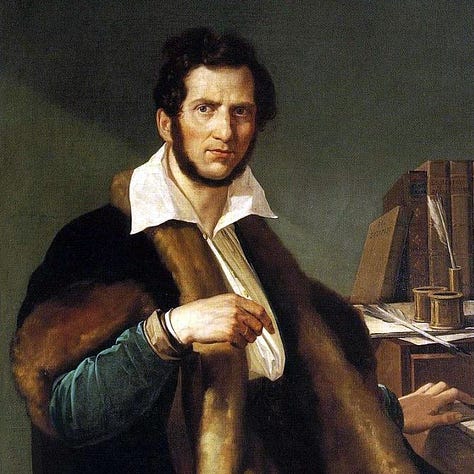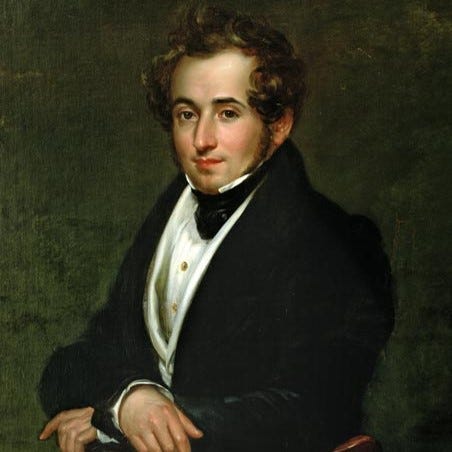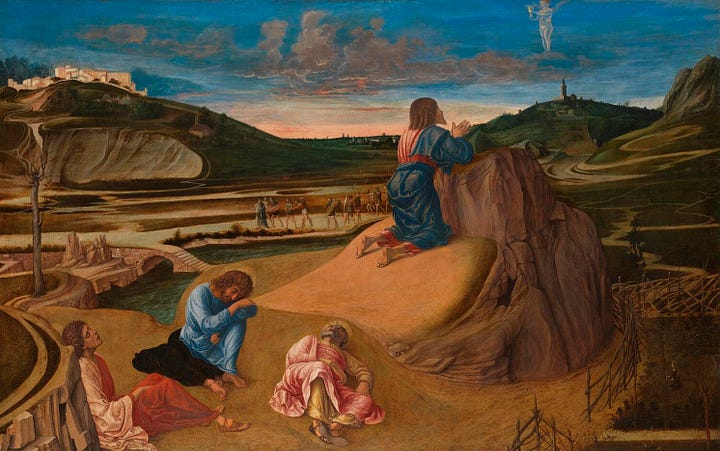Gaetano Donizetti: King of the Bel Canto Age
The life and works of a most prolific and popular composer.
You can also download the podcast on all major platforms including Apple Podcasts and Spotify.
We’re Inside Vancouver Opera. My name is Ashley Daniel Foot and today we’re profiling one of the kings of the bel canto age, Gaetano Donizetti; composer of our upcoming opera Don Pasquale, Lucia di Lammermoor, as well as La fille du régiment, The Elixir of Love, the hits go on and on... So now enjoy Gaetano Donizetti: King of the Bel Canto Age. Written and performed by Jane Potter with the voices of myself, Tom Wright, Mack McGillivray, and Pi Theatre’s Artistic Director Richard Wolfe. Audio editing is by Mack McGillivray.
On November 29, 1797, Gaetano Donizetti was born in a windowless basement apartment in Bergamo, Italy, the second son of the owner of the local pawnshop.


Donizetti’s birthplace in Bergamo (Casa Natale Donizetti)
Not very auspicious beginnings for one who would, along with his contemporaries Giachino Rossini and Vincenzo Bellini, shake up the operatic traditions of the Classical period, and create a new style of opera designed to thrill and delight audiences like never before: the bel canto era.



1797, a year that saw the birth of Austrian composer Franz Shubert, English novelist Mary Shelley, and African-American abolitionist and activist for women’s rights, Sojourner Truth, marked the start of the Romantic period: an era marked by a reverence for nature, the celebration of emotion and individual growth, a rebellion against rational thought and tradition, and curiosity for the supernatural and spiritual worlds.
Across the English Channel, poet Samuel Taylor Coleridge wrote Kubla-Khan in an opium-induced dream state, while artists Turner and Constable were mastering their craft, producing stunning works of art depicting nature at the height of her powers.
These were heady times for arts and culture across Europe that were to leave a lasting imprint and set the stage for the Bel Canto movement to take hold with Italian composers Donizetti, Rossini, and Bellini anointed as the three kings of Bel Canto.
But what is bel canto?
Italian for ‘beautiful singing’, the bel canto style was first showcased in the well-known and much-loved operas The Barber of Seville, and La Cenerentola by composer Giachino Rossini.
Featuring vocal ornamentation and appealing melodies and ensembles, Rossini’s operas charmed their audiences. Where the previous classical period called for more carefully structured operas such as Mozart’s The Magic Flute and Salieri’s Armida, bel canto composers chose dramatic expression over traditional arrangements, and allowed their singers room for vocal ornamentation that strayed from the original composition.
With an emphasis on lyrical flow and beauty, bel canto performers were given full reign to unleash their abilities and talents, conveying a full spectrum of emotion with expressive dramatic flair.
Vincenzo Bellini, a master of dramatic flair, premiered his first bel canto opera, Bianca e Fernando, in 1826, which was attended by Donizetti himself. Bellini followed with two of his most beautiful bel canto operas Norma and I Capuletti.
I know what you’re thinking, what about the drink? The Bellini, a light and airy peach prosecco delight, was named by an Italian barkeeper in the mid 1900’s for 15th century Venetian artist, Giovanni Bellini after the colour of a toga in one of his paintings. And, while there is currently no Donizetti available at the bar, you could ask for a Rossini, which substitutes strawberry puree for peach.


A Bellini Cocktail (Photo by Foodista) and Agony in the Garden (1465), one of Giovanni Bellini’s paintings which may have inspired the drink’s name.
Not to be outdone by his two contemporaries on the stage, or at the bar, Donizetti adopted Rossini’s and Bellini’s bel canto methods and styles while developing his own comedic and dramatic style. Donizetti’s first opera to appear on the main stage, Anna Bolena, opened in 1830 to great critical acclaim, and box office success.
As it happened, Rossini retired from composing in 1829, and Bellini unfortunately died at the young age of 34. So, by 1835, Donizetti was left holding the crown all to himself, with his young wife, Virginia, by his side
Speaking of crowns, during the Romantic period, audiences of continental Europe held a fascination with historical Tudor England. After Anna Bolena, which told the story of Henry VIII’s second ill-fated wife, Anne Boleyn, Donizetti further capitalized on this interest by producing two more operas: Maria Stuarda, based on the life of Mary, Queen of Scots, and Roberto Devereux, about the relationship between Queen Elizabeth I and the Earl of Essex.
Riding the wave of success from Anna Bolena, Donizetti hired a teenager - 17yr old Guiseppe Bardari - as his librettist for Maria Stuarda in which Mary Queen of Scots famously calls the first Queen Elizabeth a ‘vil bastarda’. Donizetti knew such emotional drama would both allow for expressive orchestration in the bel canto style, and appeal to his audiences, and he was right.
However, such language resulted in the opera being banned in Naples by the royal court, and it was only staged in Milan after major changes to the writing. It was, not surprisingly, Bardari’s only libretto.
In what is considered the best example of his bel canto style, Donizetti drew again from the history of the British Isles, this time adapting Scottish novelist and historian Sir Walter Scott’s novel Bride of Lammermoor, published in 1819.
Based on true events, the novel tells the story of love found and lost, revenge, madness, and tragedy, all under the gothic shadow of Scotland's lonely moors and mountains.
Lucia di Lammermoor, staged in 1835, was an instant success. Donizetti kept much of the intrigue and gothic elements of the novel intact while changing some of the characters and plot devices to better suit the bel canto style of opera: soaring arias, vocal embellishments, intricate ensemble work, plenty of drama and emotion displayed in expressive vocal work, and orchestration designed to mirror and enhance the emotional expression of the singers.
Donizetti suffered tragedy himself in 1837 when his beloved wife Virginia died. Having lost three babies in infancy, it was during childbirth that Virginia died, although there is evidence to suggest she suffered from perhaps syphilis, maybe cholera, and possibly measles.
Donizetti was so broken by her death he had trouble speaking her name for the years that followed while he remained in Naples.
Rather than one unified country as we know it today, Italy during Donizetti’s time was instead a fractured grouping of independent states with their own rulers. Donizetti spent much of his life in Naples, which was part of the Kingdom of the Two Sicilies, and included Naples and Sicily.
In 1842 after a move to Vienna, which was part of the Austrian Empire, Donizetti was appointed kapellmeister to the royal court of the Habsburgs. It was during this time that Donizetti composed Don Pasquale.
Written in the classic Italian opera buffa style, the opera in three acts featured comedic situations, mistaken identities, humorous interactions and satirical elements. Composed in the bel canto style, the opera also features vocal writing that lent itself to ornamentation and embellishment, and recitatives that provide a framework and pacing for plot advancement, and clever orchestration. First staged in January of 1843 to critical acclaim, the opera continues to be one of Donizetti’s most enduring operas, and a crowd favourite.
While the bel canto style was wildly popular with audiences, some of Donizetti’s contemporaries and critics served up sour grapes when Donizetti’s name came up.
After watching a performance of Donizetti’s The Daughter of the Regiment in Paris in 1840, French composer and music critic Hector Berlioz had this to say:
“Monsieur Donizetti seems to treat us like a conquered country; it is a veritable invasion. One can no longer speak of the opera houses of Paris, but only of the opera houses of Monsieur Donizetti.’
Berlioz may have been throwing shade here, but there is no denying how prolific Donizetti was as a composer, penning nearly 75 operas during his lifetime.
In a letter to his librettist for Torquato Tasso, Donizetti wrote:
‘Success consists of doing little and making that little beautiful, and of not singing a lot and boring the audience.’
German composer and conductor and Donizetti contemporary Felix Mendelssohn, begged to differ and wrote:
“Donizetti finishes an opera in ten days. It may be booed, to be sure, but that doesn't matter, as it is paid for all the same, and then he can go about having a good time…Therefore he sometimes spends as much as three weeks on an opera, taking considerable pains with a couple of arias in it, so that they may please the public, and then he can afford to amuse himself once more…”
Sounds like someone wishes he could finish an opera in ten days, too.
While the critics may have been harsh, those who mattered, the paying audience, could hardly get enough of his operas. Donizetti wrote the following to his older brother Guiseppe after the opening of Don Pasquale:
"The success of 'Don Pasquale' has been something unheard of. 19 times in 23 days! I had to stop everything. I was ill. The day after tomorrow, however, 'Don Pasquale' will be put on again for the first time."
Sadly, it was in 1843 that Donizetti began to suffer in earnest from illness, both physical and mental. However, he continued to compose, producing some of his best works including Linda di Chamounix, and Donizetti’s Requiem, written to commemorate the death of his close friend and fellow composer, Vincenzo Bellini.
Knowing his days were numbered, in 1844, Donizetti wrote,
“My heyday is over, and another must take my place. The world wants something new. Others have ceded their places to us and we must cede ours to still others… I am more than happy to give mine to people of talent like Verdi.”
Indeed Verdi did see Donizetti as a major influence and looked up to the older composer as a master of Italian opera scene.
In 1864, Verdi wrote to his publisher Leon Escudier, about the mad scene from Lucia di Lammermoor:
"You know Donizetti, that great composer, has written a mad scene in 'Lucia.' Well, I don't mind telling you I would have been proud to have written that myself. The public is so taken by it, so charmed by its effect, that they do not realize it is a repetition of the same phrase. It is this simplicity which gives it all its force and charm."
By 1846, life began to imitate art, and Donizetti’s own mental health deteriorated to the point where family members had him confined to a hospital in Paris where he endured various treatments, with limited success.
In late 1847, believing the Italian climate more suited for recovery, family members moved Donizetti back to Bergamo, a journey which took 17 days.
By 1848 Donizetti’s descent into madness, like many of his characters before him, was complete. He no longer recognized his friends and family, nor much of his music. His condition continued to deteriorate until, taken by a bout of apoplexy, Donizetti died on April 8, 1848 of a degenerative brain condition brought about by a severe and long-lasting syphillis infection.
Donizetti was initially buried in Valtesse, but later in 1875, his body was transferred to the Basilica of Santa Maria Maggiore in Bergamo.

While Donizetti’s death at the relatively young age of 51 may have marked the end of his prolific and successful career, his contributions to the Italian opera traditions of the bel canto era have endured to this day.
Don Pasquale is on stage at the Queen Elizabeth Theatre from February 10th to 18th. Get your tickets now at VancouverOpera.ca




Jane Potter - Writer and Narrator
Jane holds an MA in Critical and Creative writing from the University of Gloucestershire, and loves telling stories in all forms: She lives in Victoria, and when she isn’t busy reading and writing, she can be found running a small business, baking in the kitchen, or weeding the garden.
Ashley Daniel Foot - Voice of Gaetano Donizetti
Ashley is Vancouver Opera’s Director of Engagement and Civic Practice and host of Inside Vancouver Opera. Boundlessly creative and fascinated by the way that art is created and presented, Ashley has guided arts organizations across Canada to craft messages and tell unique stories.
Richard Wolfe - Voice of Felix Mendelssohn
Richard is the Artistic and Producing Director of Pi Theatre. He is a specialist in contemporary theatre and performance. Plays he's directed include the Canadian premieres of: Hir by Taylor Mac, The Events by David Greig, 1 Hour Photo by Tetsuro Shigematsu (now filmed for virtual screenings), Empire of the Son by Tetsuro Shigematsu, Long Division by Peter Dickinson, Genetic Drift by Amy Lee Lavoie, The Invisible Hand by Ayad Akhtar and Inside the Seed by Jason Rothery.
Tom Wright - Voice of Giuseppe Verdi
Tom is the General Director of Vancouver Opera. In his 15 seasons at Vancouver Opera, he has overseen the creation of more than 50 opera productions. He has stewarded the creation of new opera commissions, assembled the creative teams and development of VO’s new productions of Eugene Onegin (2009 & 2018), Nixon in China, West Side Story, The Barber of Seville, Don Carlo, Hansel & Gretel, Evita, The Overcoat – a musical tailoring, Orfeo Ed Euridice, and The Pearl Fishers.
Mack McGillivray - Audio Producer, Voice of Hector Berlioz
Mack is an audio producer, creating shows for radio and podcast. He is passionate about cultivating local community and a lifelong lover of opera.









